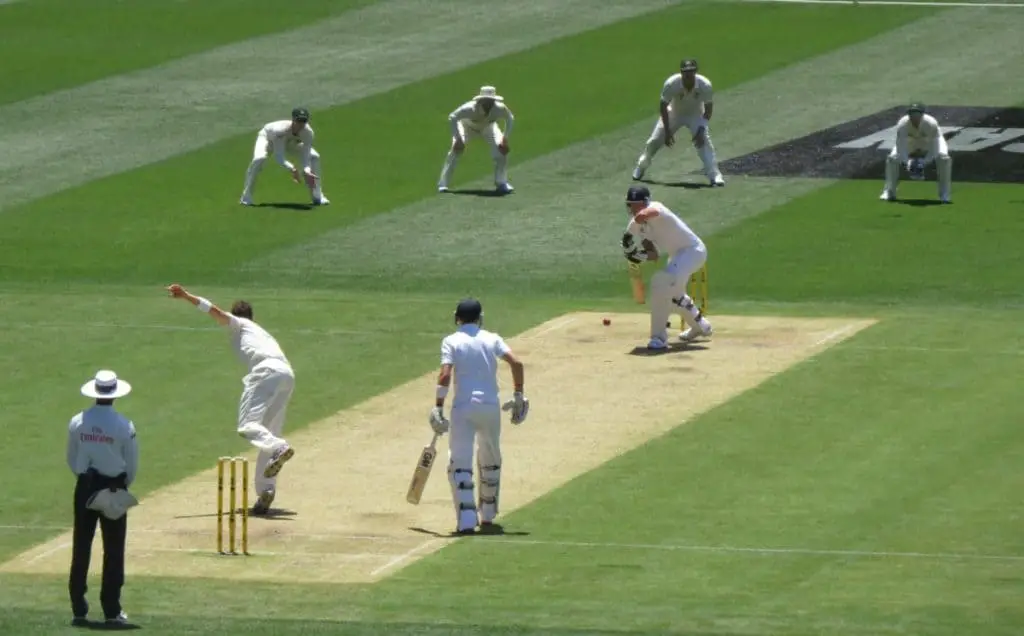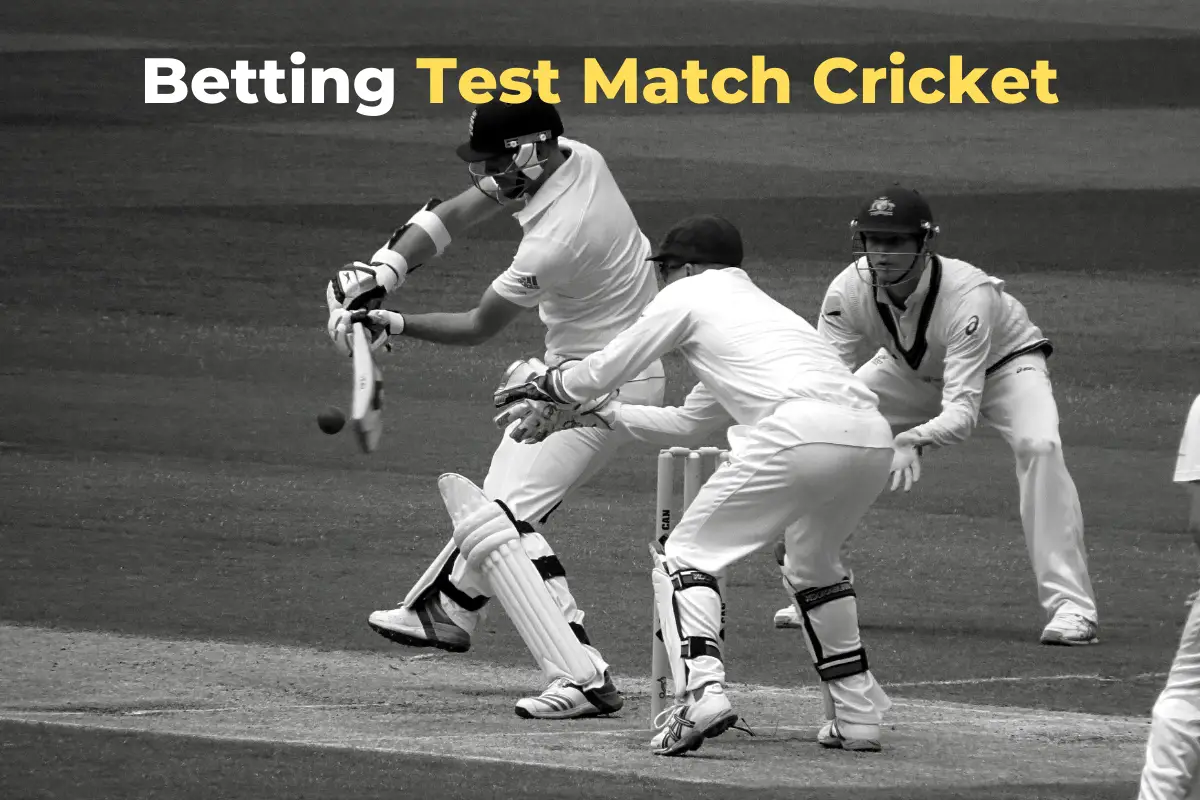A question debated in bars, online and in every country across the world; “What is the best sport to bet on?” Well if the criteria includes:
- 2 billion fans creating intense atmosphere
- Global reach for year round betting spanning all time zones
- History and tradition producing high stakes rivalries
- Endless statistical data enabling hundreds of pre-game and live markets
- Natural breaks in play for a live betting smorgasboard
- A “Draw” is a completely normal result after 30 hours of play across 5 days.
The answer is Cricket, in particular International Test Match Cricket. In this article you will discover how to make betting on test cricket work for you. Regardless if you are new to cricket or a complete tragic, its time to up your betting game.
The Basics
History Fast Facts
The format of test match cricket is just so perfectly set up for betting. The term “Test Match” got its name when a touring English team in the 1870s finally decided to allow the young developing colony of Australia play a “Test” match of cricket with 11 vs 11 players.
In the past the much stronger English team allowed the Australian team to have more players in the same match. Well in the First “Test” to see if the Australian team was good enough, the Australians won, and as such, from then on the term “Test Match” has been used.
Nowadays over 2 billion people follow Test Match Cricket across the globe and many nations have reached test status. Perfect for global bettors of the game chasing year-round markets.
The Longest Sport in the World… Perfect for Fans
Test Cricket is played over 5 days. Each day consists of 3 lots of 2 hour long sessions. Each session consists of about 30 overs (overs contain 6 balls/pitches). This results in a day’s play of around 540 balls bowled; potentially 2700 balls bowled in a 5 day Test match. A staggering amount considering the average MLB game features less than 300 pitches for a completed match.
Cricket has the highest opportunity to find value based on a few key elements.
How to Win a Test Match
Test match cricket allows each team to bat twice (called innings) and as such the same 11 players must also field (with a few exceptions will be discussed later). To win a Test match, teams need to score more runs across the 2 innings and have dismissed the other team twice completely before being crowned the winner.
There is no limit as to how long a team can bat, but if they bat for too long they will limit the time they have to completely dismiss the opposition to claim the victory. As a result teams are able to “declare” or choose to stop their batting innings, however in doing so they run the risk of the other teams chasing down the runs required to win the match.
It is all part of the tactical game of chess that team captain enjoy throughout the five days. As the game ebbs and flows odds fluctuate, sometimes wildly, providing untold opportunity for the informed bettor.
Check out this short video that truly capture the highs, lows and all the action that comes from this high stakes game:
Which Teams Play Test Cricket?
Whilst many more nations play T20 cricket only a select view nations qualify and are fully competitive in the packed annual schedule of International Test Cricket. Below is a list of all Test Cricket playing nations and the year in which they started playing.
| Year | Country |
| 1877 | Australia |
| 1877 | England |
| 1899 | South Africa |
| 1928 | West Indies (15 Carribbean Nations combined) |
| 1930 | New Zealand |
| 1932 | India |
| 1952 | Pakistan |
| 1982 | Sri Lanka |
| 1992 | Zimbabwe |
| 2000 | Bangladesh |
| 2018 | Ireland |
| 2018 | Afghanistan |
Home Ground Advantage
Home ground advantage in Test Cricket is a major factor that simply cannot be ignored.
Despite cricketers;
- Being accustomed to global travel
- Enjoying outstanding genuine 5 star accommodation
- An entourage of doctors, physios, coaches, managers
- Play each other more often in franchise T20 cricket.
Touring teams just struggle. Across the history of the game the team playing on home soil is hard to beat.
The home ground advantage is difficult to overcome for the visiting team across a 5 day match. Much like the way tennis players are more suited to their native court surface. The home environment, including the pitch conditions, the atmosphere changes and weather extremes are vastly different across the world. Simply put in your own backyard, you dictate the conditions. Which brings us to the next point.
The Pitch is Important!
The 22 yards of rolled grass and dirt stretching between the two sets of wickets is where the bulk of the game occurs. Needless to say the way the pitch plays has an enormous bearing on team selections and game style and of course betting!
For example in Asian countries cricket pitches tend to lack bounce, play low and best suit slower spin bowlers. In the UK, South Africa, West Indies and Australia the wickets tend to bounce more, not break up and don’t have variable bounce until late on the 4th day and into the 5th day of the match. Teams in these countries will tend to have a strong fast bowling attack with just the one spin option.
As a general rule of thumb this is how pitches play:
| Day | Conditions Favor? | What to Expect |
| 1 | Bat and Ball | Moisture is still in the pitch and the wicket may appear with a green tinge. Some give in the pitch when the ball bounces and it is susceptible to deviate or “seam” when the ball strikes the pitch.Expect some early wickets. The ball generally stays in good condition. Best batting conditions in session 2 and 3 |
| 2 | Bat | A beautiful time to bat. The moisture and deviation has all but gone and the wicket doesn’t have too much wear and tear from the day before. Runs should be made. |
| 3 | Bat | Great batting conditions. The wicket will keep low maybe 2-5 balls for the day and foot marks from the bowlers start to show more wear & tear and become deeper for the spinners to aim at. Batting team should still have upper hand. |
| 4 | Bat and Ball | The morning session is generally good for batting but by the end of the day, it becomes much harder for the batting team. Bowlers footholes get deeper, the wicket is dryer and will be receptive to spin more but also keep low. Quality bowlers will pepper the same area of the pitch to extract variable bounce and seam to their advantage. Late wickets likely. Momentum shifts possible. |
| 5 | Ball | This is the most difficult day to bat. Often the game is still on the line including the draw. Teams can struggle to chase down seemingly small totals due to the decreasing quality of the pitch. Expect drama. |
What is All the Fuss About the Ball?
When it comes to the actual ball, test cricket is the most unique sport in the world. The Bowling teams get one new ball at the start of their fielding innings. Other than the rare occasion that the ball is knocked out of shape and replaced, the same ball is used for the next 80 overs (480balls). It will experience a lot of wear and tear and the bowling teams can use this to their advantage and so can bettors.
Traditionally teams use their fast bowlers while the ball is newer, hard and full of bounce. At this point it has a nice pronounced seam which allows deviations (called “seam”) when it bites into the pitch. It also has plenty of shine, which allows the ball to curve (called “swing”) through the air. Teams with a strong fast bowling unit are a big chance of taking wickets with the new ball.
However as the fast bowlers tire and the ball gets older and rougher, it is more likely to grip to the pitch and as such the spin bowlers come into play. They can bowl long spells due to the less strenuous bowling action. This means they bowl bulk overs, sometimes to contain the scoring and other times to strike. Once the new ball is available (80 overs) the fast bowlers often are brought back into attack and the cycle goes again until the batting team is either completely dismissed, or declares their innings finished.
Why is the Coin Toss Before the Match So Important?
To start a cricket match the home captain will toss a coin. The winner will then decide if their team chose to bat or bowl first. This is usually based on the pitch condition and the weather at the start of the match. As a general rule of thumb the old saying goes,” 90% of the time bat first, the other 10% of the time think about Bowling but bat first anyway”.
However Old sayings are becoming just that, and more Captains are choosing to bowl first in this day and age. The danger of bowling first, is batting last when the pitch is more suited to the bowlers and scoring is difficult..
The Seven Major Test Cricket Markets: How To Bet Them!
1. Result of the Match (Outright Winner)
Pre-match all good sportsbooks will offer moneyline markets (Head to Head) for 3 possible outcomes: Team A to win, Team B to win or Match finishes in a the Draw. Yes you heard right, the Draw.
Just like a good 90 minute Soccer match, Test Cricket can end in a draw and be completely enthralling. Much to the dismay of the non traditional cricket fan. Some of the great performances in the history of cricket have been where a player performs the extraordinary to save the match and get the draw. Live to fight another day.
Sportsbooks will offer live odds throughout the match on all 3 possible results. Playing the long game and ‘trading’ or hedging bets is quite common for those looking to grind out a profit after 5 days. It’s also a ton of fun.
While markets may be suspended for a short period of time when a batter is dismissed as algorithms reframe the market, the opportunity to hit value odds appear all day. With potentially 2700 individual deliveries being bowled during a match, keen followers can spot when it’s time to strike.
The Takeaway:
For insurance some bettors like to bet on “DRAW NO BET” meaning if the match is a draw the bettor gets their money back. The odds are less, so backing a short favorite may not be the most profitable option here. Picking when to use this bet type may not suit every match.
Learn to bet live on the Moneyline market. Use the volatility to your advantage. Many times early fluctuations in the odds are overstated as there is a long time for teams to work their way into a game. Bet against the over reactions to early wickets of large opening stands.
2. Leading Individual Run Scorer
If you think a batter is in form and may score the most runs for a particular team in each innings, then this is the bet type for you.
The recognised batters for a team will be shorter priced than the much less fancied lower order who offer very juicy odds. Much like betting on horses, the short priced favourites are such for a reason but offer limited value.
The Takeaway:
In the first innings of the match teams usually bat till all 10 wickets have fallen due to the nature of the game, there is still plenty of time in the match to win the game, and batting is the best condition possible towards the start of the match.
Roughies/ Longer odds Batters coming in lower down the order are at least a chance of batting. In the 3rd and 4 innings these tend to be the least completed innings and the lower order may not get a bat in their teams 2nd innings.
A sneaky play here is to look for a middle order batter to score well when a team has been sent in to bat. Often the bowling team will land some early blows and knock over the top order before batters 5 through 7 get the best of the batting conditions.

3. Leading Wicket Taker
Most teams pick 4-6 players that can bowl to a high enough standard to take wickets, because after all, without taking wickets teams are not going to win the game.
Most quality sports books will offer odds on this market, but only those likely to bowl will appear in the market. Like the Leading run scorer, the favourites are just that for a reason. They are proven performers and the odds reflect this.
However unlike the batters who make one mistake and they are out, bowlers that bowl poorly, may end up coming back later in the day for a second spell and third spell and it only takes one good ball to take a wicket (sometimes even a bad one does the job). Do that a few times and all of a sudden they have 4-5 wickets and are well on the way to winning the match for their team.
The Takeaway:
In this market, ties are common. When sharing 10 wickets across 4-6 bowlers it is quite common for 2 players to finish with 3 wickets and the other bowlers to take a couple each. If this is the case a bettor will get a return of half their expected win. If 3 bowlers tie, then it is a third of the expected return. Some bettors have been known to back 2 or 3 bowlers to increase the chances of a return if the price is right for a positive return if one bet gets up.
Look for a bowler who can knock over the lower order bats, referred to as ‘cleaning up the tail’. As far as the leading wicket taker market is concerned, a wicket is a wicket, regardless of the talent of the batter. A bowler can chime in with 3 or 4 late wickets by bullying the tail and steal the leading wicket taker win.
4. Mode of Next Dismissal
A wicket keeper performing a stumping:
There are only a few ways a batter can be dismissed in cricket:
| Mode of Dismissal | What is it? | How Often it Occurs |
| Bowled | The ball smashes into the stumps and dislodges the bail | 21.43% |
| Leg Before Wicket (LBW) | The ball strikes the body (usually the legs) of the batter and the ball was expected to go on and hit the stumps. | 14.30% |
| Caught Behind | A ball comes off the bat and is caught by the wicket keeper before the ball hits the ground | 16.27% |
| Caught Fielder | A ball comes off the bat and is caught by any fielder (other than the wicket keeper) before the ball hits the ground | 40.65% |
| Run Out | While attempting a run, the batter doesn’t make it back behind the crease before the fielders throw the ball and strike the wickets. | 3.51% |
| Stumped | Much like a run out, except it occurs when the batter leaves their crease to attempt to hit the ball and misses it. The wicketkeeper then strikes the stumps with the ball in their gloves, dislodging the bail. | 2.03% |
| Less Common Methods | Handled the Ball, Timed Out, Obstructing the Field, | 1.81% |
Source: Analysing Test Cricket Dismissals Across the Ages
The Takeaway
In overs 30-70 this is when spin bowlers usually operate. It is here that batters scoring rate may be pinned down. In particular in the 3rd and 4th innings when the bounce is becoming variable and the pace of the game is changing. Spin bowlers will use deception to spin the ball past a “dancing batter”, as such Stumpings come into play, even against part time spin bowlers. Look for the quality spinner, frustrated/pinned down batter and quality keeper. This market will come more into play and the odds are generous.
Not a lot happens in the overs before a new ball is taken. Usually the ball offers little for the bowlers and batters have experienced all the tricks the spin bowler has thrown at them. However when the New Ball is taken after 80 overs the game comes to life. The fast bowlers return with new vigor and LBWs come into play. Scoring also tends to increase as the ball pings off the bat This is due to the extra pace/bounce/seam and swing a new ball can provide. Be ready for wickets!
Note also on Day 1 the 80th over is late in the day (10 overs remaining) and shadows are longer and the quality of light has changed since the middle of the day. A perfect storm for late drama in the mode of dismissal market!
5. Individual Player Markets
A very popular betting market where bettors back either their player to score over or under a certain amount of runs in an innings, or take under or over a certain amount of wickets.
Much like Line betting in most sports this type of bet will feature increased sportsbook edge or ‘vig’. It’s a way to mitigate risk for the sportsbooks. This is the price you pay to be part of these markets. Betting live on these markets is a huge drawcard.
The Takeaway
Not all sportsbooks will offer Under odds, so sometimes not betting at all may be the best option if bettors are not happy with the overs price or placement. If no unders are offered sportsbooks can take some liberties on the line they offer. It’s usually a little higher than it should be. Other markets may be more suited for this match.
6. First Innings Lead
Team like to obtain that psychological advantage of having first innings lead (on runs) after both teams have batted once. As a result, sportsbooks will offer this market. This is popular because as a general rule, both teams will get a chance to fully complete their innings, or to score enough for their team to declare. Rarely will the chasing team declare lower than their opponents score, but it can happen if they are looking to get a result from the match when chasing a series victory.
The Takeaway:
The toss is important, teams batting first in conducive conditions on a quality pitch will have their odds shorten if they win the toss. It is a significant advantage. Note that Day 2 and 3 can sometimes be the best time to bat and in fact the team batting 2nd may have the best conditions to score runs. The trade off here is they will also bat last on a potentially deteriorating surface.
7. Player to Score 50 or 100 +Runs
Cricket is a very traditional game and as such today’s greats walk in the same corridors as the greats of the past. The corridors of dressing rooms are covered in honour boards of great achievements. In cricket scoring 100+ runs in a single innings is a highly regarded personal honor often used to measure greatness. Players often get into the “nervous 90’s” as they approach this score with many legendary tails of batters being dismissed for 99, or even 199…ouch!! Some players score 100+ runs more than others while some can only dream of such a feat. Reaching “50” runs for a batter is a good “half-way” milestone and does get acknowledged by the fans and the players’ dressing room. Due to the nature of these milestones sportsbooks offer markets on whether players will score at least 50 or 100 runs in a single innings.
The Takeaway:
On the way to scoring 100+ runs the batter will obviously go past score 50+, if betting both markets the bettor can achieve a midway payout as a form of insurance.
Quality sports books will payout as soon as the milestone is reached rather than waiting until a batter is dismissed. Better to have the cash back in your hands as soon as possible.
It might be worth backing multiple batters to score 50+ or 100+ in the same innings if conditions appear to favor batting. Note though, players further down the batting order will be batting with weaker batters and may “run out of partners” before achieving the target you bet on. As such the markets usually offer longer odds on lower order batters to score milestone totals.
Other Stuff to Help You Bet on Test Cricket:
Series Betting
Test match cricket is played in series between nations. Obviously due to the international nature of the sport, one team is the host and the other is ‘touring’. A return series may not be played for two years or more following.
Series can be anywhere between 2 matches and 5. It is up to individual governing bodies to get together in the months preceded the series to work out what combination of matches will be played.
The team who wins the series wins the ‘trophy’ (some are very prestigious). In the next series the team who holds the trophy only has to draw the series to retain the trophy.
The Takeaway:
Factor this in when betting series winner markets. The drawn series is a real possibility. Weather can contribute to this scenario also as it’s not unusual for significant amounts of time to be lost to rain.

The ICC Test Match Championship
Whilst test matches are played in series, teams are also earning points from each match towards the ICC Test Championship trophy. The prestigious award is decided after 72 matches between the 9 nations in a 2 year cycle (Yes, its complicated).
The two leading teams at the end of this cycle play a one off final to decide the overall Test Champion. This prestigious award has prize money to match. 72 matches across 2 years doesn’t seem like many games. But considering matches last 5 days. This works out to a total of 360 days, of the highest level cricket on earth. With only 9 teams, there is plenty of opportunity to learn how to master betting on this global sport.
The Takeaway:
The introduction of the Test Championship has made what used to be dead rubbers (matches played after a series is already decided) very important. Winning a series 3-1 instead of 2-1 makes a big difference in the Test Championship standings. Keep this in mind when betting series winner correct score markets.
Consider Avoiding This Betting Type
“Highest Opening Partnership”. This is fraught with danger. Because as a Bettor you do not have all the best information required, there are too many variables and the risk may not be worth the reward. In cricket, the weather conditions are so important to the how the match is played. The time between the opening partnership of 2 teams could be 2 days. For example, one team may bat in blazing sunshine, whilst the other may face overcast conditions suited to swing bowling
The Takeaway:
Try to bet all markets as close to live as possible. Then bettors can bet with the most amount of information possible at their disposal.
A Trap
Strong player performances in short form cricket does not always translate to the longer form test cricket. The ability to bowl for long spells consistently and to bat for long periods of time is why so many fans love the saga 5 day cricket provides. A rare few superstars are capable across all 3 formats and as such these players usually have a bank balance to match their skill set.
The Takeaway:
Be wary when betting on matches early in the series if it was preceded by short form cricket. There is an adjustment period moving to longer forms and some players handle that transition better than others.
The Game Starts Now!
There are few sports that can match the drama and tension of test match cricket. Lovers of the game have been betting on this great sport since the first epic battle all those years ago. Don’t you think it’s time you considered adding test match cricket to your betting repertoire? You may just find a new favorite thing!
Good luck and as always, gamble responsibly.



